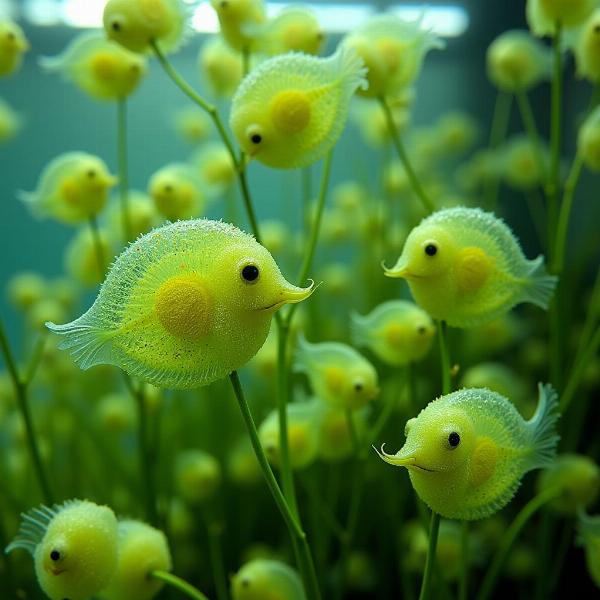Rotifers, microscopic aquatic animals, are known for their unique rotating wheel-like structure called the corona. Understanding their meaning in Hindi helps us appreciate their significance in the Indian ecosystem and scientific research. This article delves into the various aspects of rotifers, including their biological classification, ecological role, and importance in aquaculture. We’ll also explore the Hindi terminology associated with these fascinating creatures.
What are Rotifers? Understanding their Hindi Terminology
Rotifers, scientifically classified as phylum Rotifera, are predominantly found in freshwater environments, although some species inhabit saltwater or moist soil. Their defining feature, the corona, creates water currents that aid in both feeding and locomotion. In Hindi, rotifers are often referred to as “चक्राणु” (chakraanu), which literally translates to “wheel-organism,” perfectly capturing their distinctive characteristic. Other terms like “घूर्णी प्राणी” (ghurni prani), meaning “rotating animal,” are also used. Knowing these Hindi terms can facilitate communication and learning about these organisms within the Indian scientific community and among nature enthusiasts.
The Ecological Importance of Rotifers in India
Rotifers play a crucial role in the aquatic food web. They serve as a primary food source for various aquatic organisms, including fish larvae and small crustaceans. Their abundance in freshwater bodies like ponds, lakes, and rivers across India contributes significantly to the overall health and balance of these ecosystems. They are also excellent indicators of water quality, as their populations are sensitive to pollution and environmental changes.
 Rotifers in aquaculture
Rotifers in aquaculture
Rotifers in Aquaculture: A Growing Industry in India
The aquaculture industry in India is rapidly expanding, and rotifers have emerged as a vital component of this growth. They are an ideal live food source for fish larvae due to their small size, high nutritional value, and ease of cultivation. Their use in hatcheries helps ensure the successful development of fish fry, contributing significantly to the overall productivity of fish farms. This, in turn, supports food security and economic growth within India.
Delving into the Anatomy and Physiology of Rotifers
Rotifers, despite their microscopic size, possess a complex internal structure. They have a complete digestive system, including a mouth, pharynx, stomach, and intestine. Their nervous system consists of a brain and a network of nerves that extend throughout their body. Understanding their anatomy and physiology in detail can further illuminate their adaptability and success in various aquatic environments.
The Significance of Studying Rotifers
Studying rotifers provides valuable insights into various biological processes, including evolution, ecology, and developmental biology. Their short lifespan and ease of cultivation make them ideal model organisms for laboratory research. Their sensitivity to environmental changes makes them useful in ecotoxicological studies, helping researchers assess the impact of pollutants on aquatic ecosystems.
Conclusion: The Microscopic World of Rotifers
Rotifers, though tiny, play a significant role in the aquatic ecosystems of India. Understanding their meaning in Hindi – चक्राणु (chakraanu) or घूर्णी प्राणी (ghurni prani) – allows for a deeper appreciation of these fascinating creatures. Their importance in the food web, their contribution to the growing aquaculture industry, and their use in scientific research underscores their value. Further research and awareness about rotifers can contribute to a more comprehensive understanding of aquatic life and its impact on our environment.
FAQs: Frequently Asked Questions about Rotifers
- What is the primary function of a rotifer’s corona? The corona is primarily used for feeding and locomotion. It creates water currents that bring food particles towards the rotifer’s mouth and helps it move through the water.
- Where are rotifers typically found in India? Rotifers are commonly found in freshwater bodies across India, including ponds, lakes, rivers, and even moist soil.
- Why are rotifers important for aquaculture? They serve as a crucial live food source for fish larvae, contributing significantly to the success of fish farming.
- What is the Hindi word for rotifers? Rotifers are often referred to as “चक्राणु” (chakraanu) or “घूर्णी प्राणी” (ghurni prani) in Hindi.
- How do rotifers contribute to the aquatic food web? They are a primary food source for various aquatic organisms, including fish larvae and small crustaceans.
- Why are rotifers considered good indicators of water quality? Their populations are sensitive to pollution and environmental changes, making them useful indicators of water health.
- What is the significance of studying rotifers in scientific research? They are used as model organisms for various biological studies, including evolution, ecology, and developmental biology.
Meaning-Hindi.in: Your Partner in Hindi Translation
Meaning-Hindi.in is a leading provider of professional Hindi translation services, specializing in various domains, including business, legal, technical, website localization, and academic translation. Our team of expert translators ensures accurate and culturally sensitive translations, bridging the language gap for businesses and individuals alike. Whether you need to translate business documents, legal contracts, technical manuals, or educational materials, we can provide high-quality, reliable, and timely services. Contact us today for all your Hindi translation needs. Email: [email protected] Phone: +91 11-4502-7584 Let Meaning-Hindi.in be your trusted partner in connecting with the Hindi-speaking world.